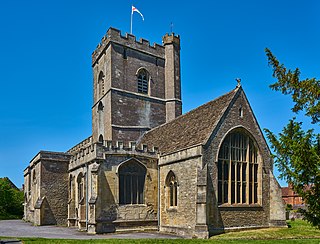
The Church of St. Peter and St. Paul is a parish church of the Church of England in Godalming, Surrey. The parish is mostly urban and excludes rural outskirts, it includes another church, St Mark's, in which the joint clergy provide less formal and family services.

Fovant is a village and civil parish in southwest Wiltshire, England, lying about 9 miles (14 km) west of Salisbury on the A30 Salisbury-Shaftesbury road, on the south side of the Nadder valley.

Long Newnton is a small village and civil parish in Gloucestershire, England, lying on the B4014 road between Malmesbury and Tetbury. It is near the SW end of the Cotswolds. The population of the parish was 211 at the 2011 census.

Shrewton is a village and civil parish on Salisbury Plain in Wiltshire, England, around 6 miles (9.7 km) west of Amesbury and 14 miles (23 km) north of Salisbury. It lies on the A360 road between Stonehenge and Tilshead. It is close to the source of the River Till, which flows south to Stapleford.

The Church of St James in Winscombe, Somerset, England, has 12th- or 13th-century origins but the present building dates from the 15th century. It is a Grade I listed building.

The Church of St Mary Magdalene is the Church of England parish church for the village of Ditcheat, Somerset, England. There has been a church on the site since 824, and the present building owes much of its grandeur to the Abbots of Glastonbury. Historic England have designated it a Grade I listed building.

The Church of the Holy Cross is the Grade I listed Anglican parish church in the village of Sherston, Wiltshire, England. It has Norman origins and contains many interesting religious items, including remains of Norman wall decoration, and a crucifix donated to the church by Italian soldiers during World War II.

The Tetbury Avon, also known as the River Avon, Little Avon or Ingleburn, is a tributary of the Bristol Avon in south-west England. It rises at Tetbury in Gloucestershire and flows in a generally south-easterly direction, joining the Sherston Avon at Malmesbury in Wiltshire. The water flow has been reduced by public water extraction from its source aquifer in the Cotswold Hills. In the past watermills were used for fulling wool and grinding corn; one working mill survives.

St Mary's Church in the Maddington area of Shrewton, Wiltshire, in the west of England, was built in the late 12th century. It is recorded in the National Heritage List for England as a designated Grade II* listed building, and is now a redundant church in the care of the Churches Conservation Trust. It was declared redundant on 29 December 1975, and was vested in the Trust on 26 July 1979.

St Mary's Church is a redundant Anglican church in the village of Shipton Sollars, Gloucestershire, England under the care of The Churches Conservation Trust. It is recorded in the National Heritage List for England as a designated Grade I listed building,
John Hungerford was an English MP.

Lasborough is a settlement in Gloucestershire, England, part of the Westonbirt with Lasborough civil parish. Lasborough lies to the west of the A46, about two miles north of Leighterton, two miles south of Kingscote and five miles west of Tetbury.

St James's Church is the main Church of England parish church for the town of Trowbridge, Wiltshire, England. The 15th-century Grade I listed building is the town's most prominent landmark.

St Michael's Church is the Church of England parish church in the town of Melksham, Wiltshire, England.

The Church of All Saints is the main Church of England parish church in Westbury, Wiltshire, England. There has been a church on the site since Saxon times, and the current church, largely rebuilt around 1437, is a Grade I listed building.

St Denys' Church is the parish church of the town of Warminster, Wiltshire, England, and is the town's oldest church. Begun in the 11th century, rebuilt in the 14th and restored in the 19th, it is a Grade II* listed building.

The Church of St Peter and St Paul is an Anglican church in Tring, Hertfordshire, England, and in the Diocese of St Albans. The building is Grade I listed. Although extensively restored in the late 19th century, it is largely a 15th-century building.

Dursley Town Hall, also known as Dursley Market Hall, is a municipal building in the Market Place, Dursley, Gloucestershire, England. The structure, which is mainly used for markets and community events, is a Grade II* listed building.

The Church of St Giles is the Church of England parish church for the village of Wimborne St Giles, Dorset. Originally founded in the 13th century and rebuilt several times over the ensuing centuries, the present church is a mixture of Georgian and Gothic Revival architecture. It is located at the start of the main driveway to St Giles House, the seat of the Earl of Shaftesbury, at the end of a row of Stuart-era almshouses.

The Church of St Laurence is the main Church of England parish church for the village of Downton, Wiltshire, England. An unusually long building for a village church, the present structure dates from 1147. Continually altered and enlarged until the mid-19th century, the church displays every style of architecture from the Norman to Victorian eras, and has been designated a Grade I listed building.
























